China seems to be taking a cue from Ukraine’s fate under the Russian cruise missile and suicide drone attack that knocked out its energy infrastructure and other critical assets.
Chinese PLA appears to be borrowing a tactic from World War 1 and 2 – employing massive ‘barrage balloons’ to protect its cities from low-level cruise missile strikes.
The tactic was practiced in the recent civil-military air defense exercise, ‘Zhejiang Golden Shield 2022,’ which also saw China camouflaging its oil storage tanks in the city.
In eastern China, the exercise was held in Wusong in Huzhou, part of Zhejiang Province. Both military and civilian departments took part in the exercise with a total of 200 personnel, 20 vehicles, 15 ships, and 20 unmanned aerial vehicles (UAV).
🇨🇳 #Zhejiang 2022 Golden Shield civil air defense exercise was held in #China. #Military and civilian departments accepted the exercise. In total, up to 200 personnel, 20 vehicles, 15 ships, 20 unmanned aerial vehicles were involved. Location: Wusong (Huzhou, Zhejiang Province) pic.twitter.com/xf9hHRXHgu
— BruteMarxist18 (@BruteMarxist18) November 18, 2022
What Are The Balloons For?
The balloons are known as barrage balloons, interestingly suggested for Ukraine in a Forbes article to intercept low and medium-altitude flying cruise missile strikes. The gas-filled balloons are tethered to the ground and, when deployed in large numbers, make low-level flights challenging attacking aircraft, missiles, or helicopters dangerous.
They might also potentially complicate an adversary’s surveillance, and reconnaissance attempts to photograph critical infrastructure by becoming visual obstacles.
France, Germany, Italy, and the United Kingdom used barrage balloons in the First World War. While the French and German forces had developed kite balloons, early British barrages balloons were spherical.
In 1938 the British Balloon Command deployed balloons to defend against dive bombers flying at heights up to 5,000 feet (1,500 meters), forcing them to fly higher and into the range of concentrated anti-aircraft fire – anti-aircraft guns could not traverse fast enough to attack aircraft flying at low altitude and high speed.
During the Battle of Britain, 102 aircraft struck balloon cables, forcing 66 down, and were also responsible for 231 V-1 missile kills, the first drone aircraft.
“This is exactly the low-cost and low-tech innovation Ukraine needs as it struggles to keep contesting airspace over the Donbas region of eastern Ukraine. With its air force largely absent, Ukrainian defenders need every possible advantage as they concentrate and start pivoting towards the attack,” the Forbes article said.

PLA’s Civil-Military Air Defense Exercise
“The exercise is conducted in the conditions of development and conduct of information wars in the world,” said a post on a popular social media page that discusses Chinese military issues. While the comment’s framing is unclear, from the context, it can be assumed that the exercise serves as a deterrent to adversarial nations contemplating strikes on the Chinese mainland in the event of a war.
Based on several other comments on the page, it has been surmised that the People’s Liberation Army (PLA) is also galvanizing civil infrastructure as a part of civilian air defense.
“The work of preparing civil air defense in the event of the outbreak of hostilities, organizing the implementation of joint tasks of military and civilian structures to activate air defense, and eliminating the consequences of air strikes were worked out,” said a statement attributed to the Huzhou Civil Air Defense Command.
The exercise saw the operationalization of the Huzhou Military-Civil Joint Headquarters “to further enhance the organization and command capabilities of the military-civilian joint headquarters at all levels, fully test the ability of the civil air defense,” according to a report on the China News Service.
China has long embodied the National Defense concept even before its military advancement, preparing for a possible continental invasion from the US, Japan, or its civil war rivals, the nationalist Kuomintang (KMT) from Taiwan.
Interestingly, one of the scenarios involved protecting oil storage tanks that represented critical energy infrastructure was undertaken. The tanks were masked with covers of the same color as the terrain (green) as camouflage.
“Obviously, China is watching the events in Ukraine and sees how the energy system of Kyiv is gradually becoming incapacitated as a result of massive targeted strikes by the Russian Army,” the comment further read.
However, it is unclear if the Ukrainian scenario was the official motivating factor behind the exercise or an indication of China’s disagreement with Russia over its military intervention.
It has maintained a neutral stance on the war at the Presidential and Foreign Affairs Minister level, while its Ministry of Foreign Affairs (MFA) has criticized and blamed “reckless NATO expansion” for the conflict.
With NATO trying to gain a foothold in Asia, too, with Japanese and US help, China shares Russia’s complaint about US containment and encirclement efforts.
- The author can be reached at satamp@gmail.com
- Follow EurAsian Times on Google News